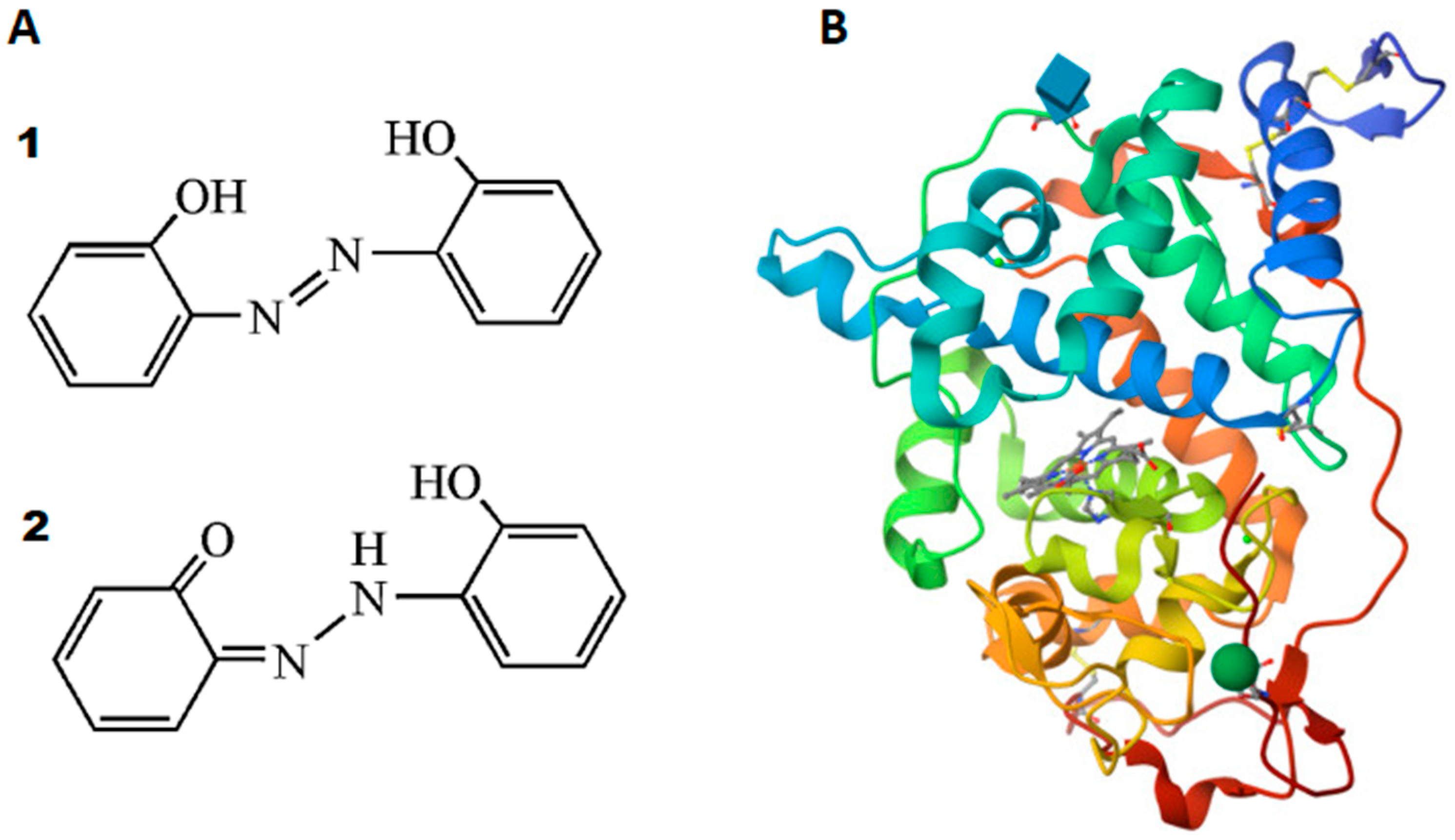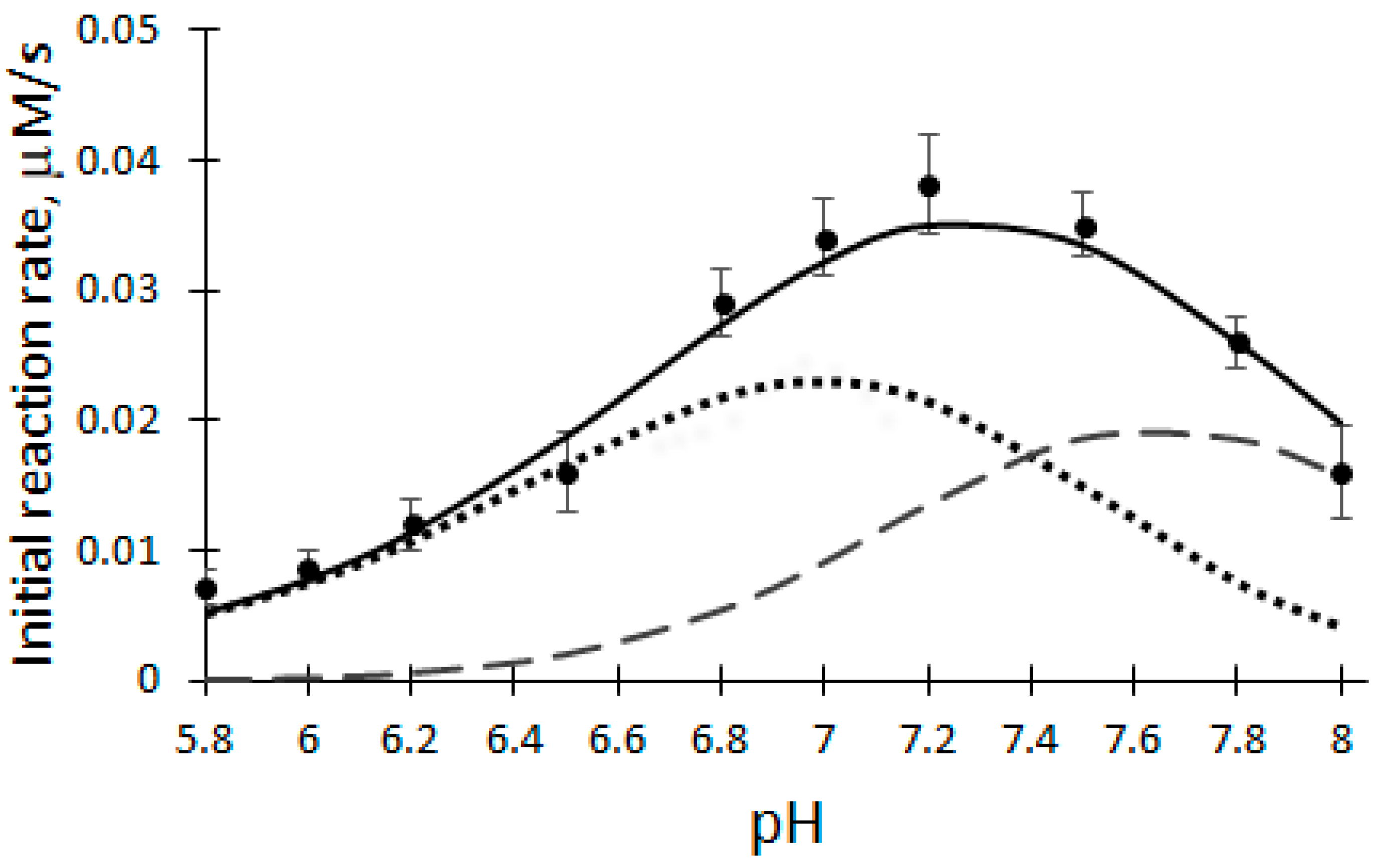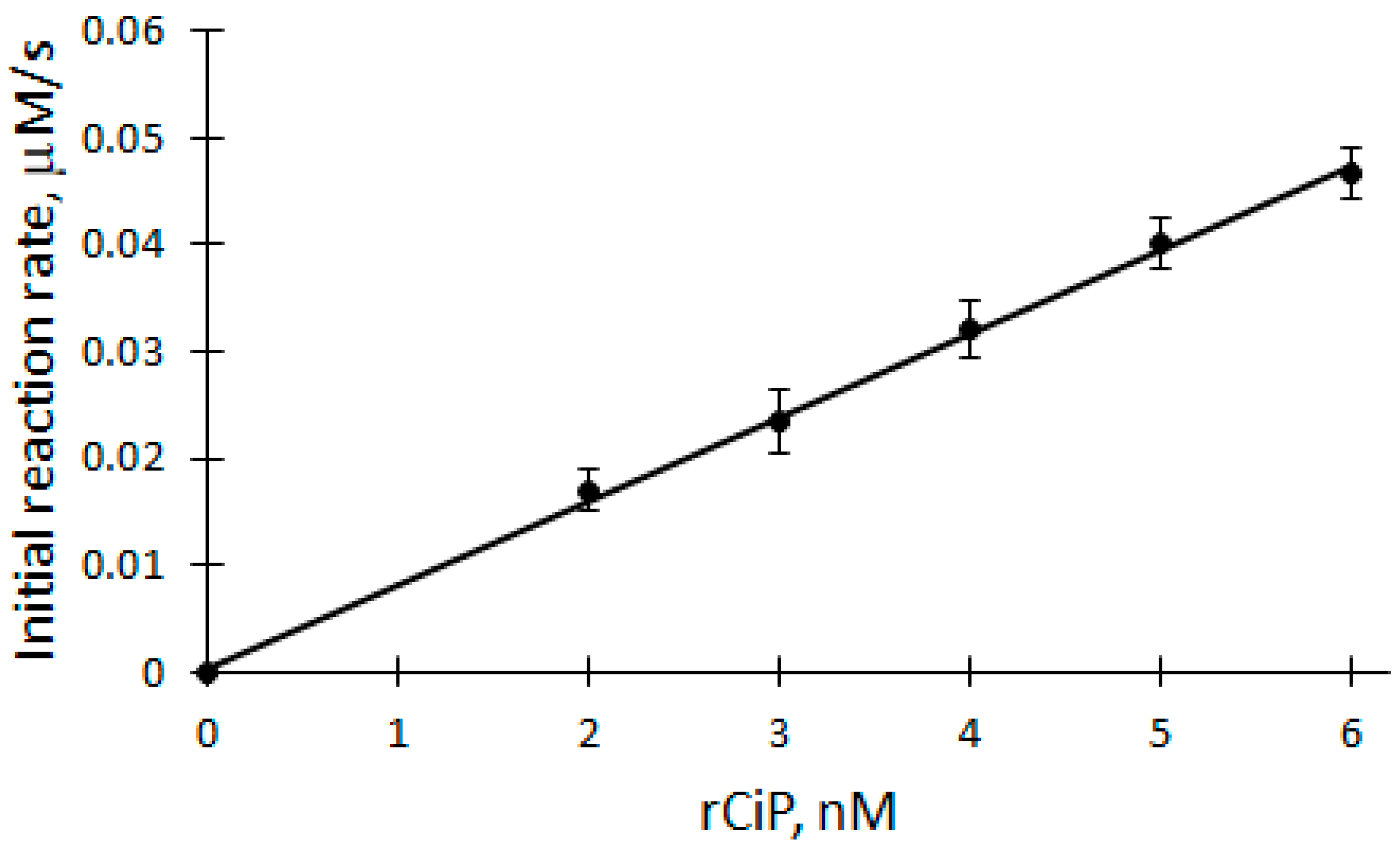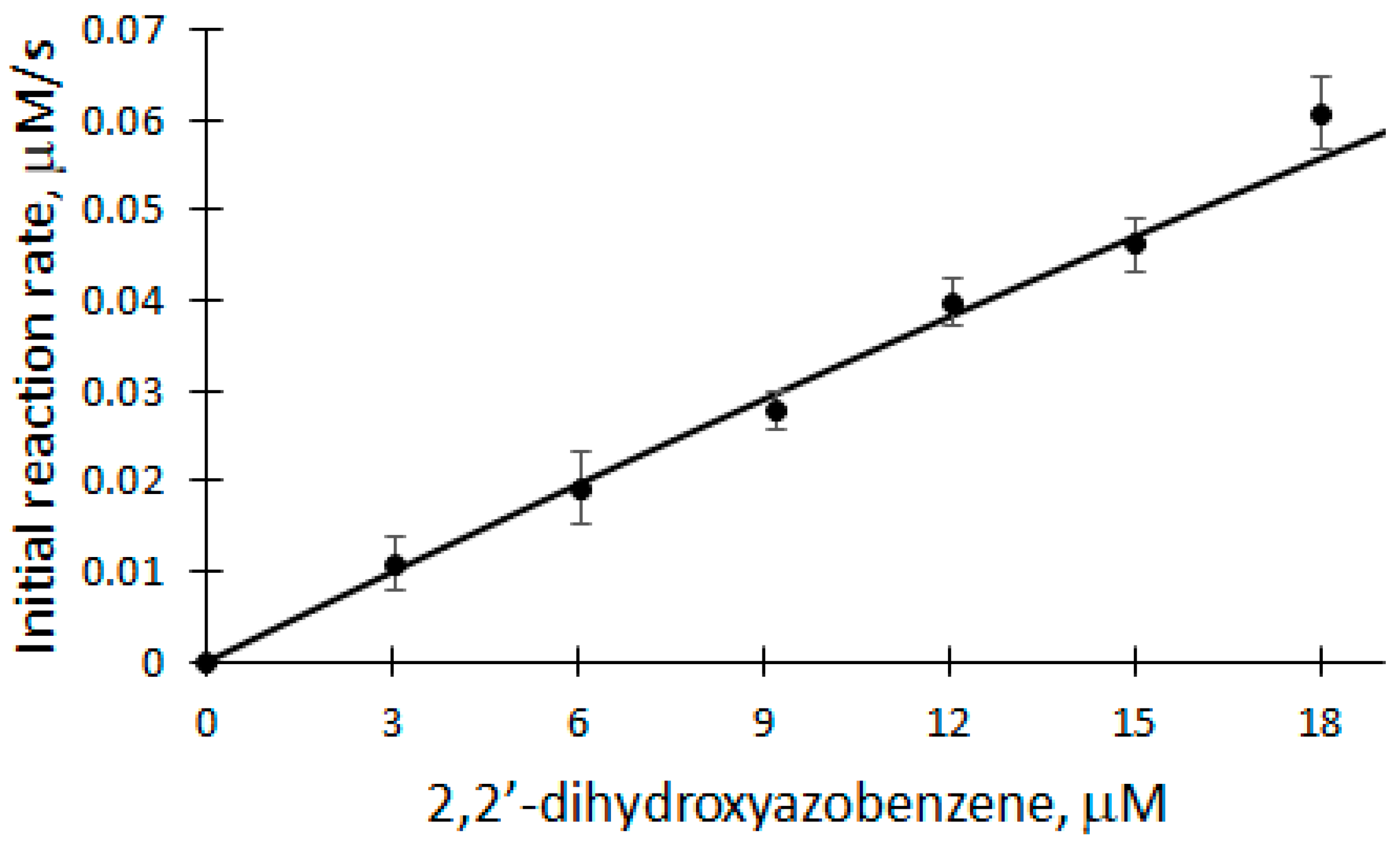Kinetic Study of Coprinus cinereus Peroxidase-Catalyzed Oxidation of 2,2′-Dihydroxyazobenzene
Abstract
1. Introduction

2. Results and Discussion
2.1. Dependence of the Initial Biocatalytic Reaction Rate on pH
2.2. Dependence of the Initial Biocatalytic Reaction Rate on H2O2
2.3. Dependence of the Initial Biocatalytic Reaction Rate on rCiP
2.4. Dependence of the Initial Biocatalytic Reaction Rate on DHAB
3. Materials and Methods
3.1. Materials
3.2. Methods
Funding
Institutional Review Board Statement
Informed Consent Statement
Data Availability Statement
Acknowledgments
Conflicts of Interest
References
- Ataei, M.; Maghsoudi, A.S.; Hassani, S. Dyes and colorants. In Reference Module in Biomedical Sciences; Elsevier: Amsterdam, The Netherland, 2022. [Google Scholar] [CrossRef]
- Benkhaya, B.; El Harfi, S.; El Harfi, A. Classifications, properties and applications of textile dyes: A review. Appl. J. Environ. Eng. Sci. 2017, 3, 311–320. [Google Scholar] [CrossRef]
- Nikfar, S.; Jaberidoost, M. Dyes and Colorants. In Encyclopedia of Toxicology, 3rd ed.; Wexler, P., Ed.; Academic Press: Cambridge, MA, USA, 2014; pp. 252–261. [Google Scholar] [CrossRef]
- Khan, N.M.; Parmar, D.K.; Das, D. Recent Applications of Azo Dyes: A Paradigm Shift from Medicinal Chemistry to Biomedical Sciences. Mini Rev. Med. Chem. 2021, 21, 1071–1084. [Google Scholar] [CrossRef] [PubMed]
- Benkhaya, S.; M’rabet, S.; El Harfi, A. Classifications, properties, recent synthesis and applications of azo dyes. Heliyon 2020, 6, e03271. [Google Scholar] [CrossRef] [PubMed]
- Jánossy, I.; Tóth-Katona, T. Photo-Orientation of Liquid Crystals on Azo Dye-Containing Polymers. Polymers 2022, 14, 159–171. [Google Scholar] [CrossRef] [PubMed]
- Ranjitha, B.S.; Kumari, D.S.; Shetty, A.; Shanker, G.; Alaasar, M.; Pashameah, R.; Hegde, G. Impact of terminal group on azobenzene liquid crystal dimers for photo-responsive optical storage devices. J. Mol. Liq. 2023, 383, 121985. [Google Scholar] [CrossRef]
- Tkachenko, I.M.; Kurioz, Y.I.; Kravchuk, R.M.; Shekera, O.V.; Glushchenko, A.V.; Nazarenko, V.G.; Shevchenko, V.V. Azobenzene–N-salicylideneaniline based aromatic polymers as efficient light-responsive materials. Polymer 2023, 279, 125991. [Google Scholar] [CrossRef]
- Imperatore, C.; Varriale, A.; Rivieccio, E.; Pennacchio, A.; Staiano, M.; D’Auria, S.; Casertano, M.; Altucci, M.; Valadan, M.; Singh, M.; et al. Spectroscopic Properties of Two 5′-(4-Dimethylamino)Azobenzene Conjugated G-Quadruplex Forming Oligonucleotides. Int. J. Mol. Sci. 2020, 21, 7103. [Google Scholar] [CrossRef]
- Imperatore, C.; Valadan, M.; Tartaglione, L.; Persico, M.; Ramunno, A.; Menna, M.; Casertano, M.; Dell’Aversano, C.; Singh, M.; d’Aulisio Garigliota, M.L.; et al. Exploring the Photodynamic Properties of Two Antiproliferative Benzodiazopyrrole Derivatives. Int. J. Mol. Sci. 2020, 21, 1246. [Google Scholar] [CrossRef]
- Ali, Y.; Abd Hamid, S.; Rashid, U. Biomedical Applications of Aromatic Azo Compounds. Mini Rev. Med. Chem. 2018, 18, 1548–1558. [Google Scholar] [CrossRef]
- Mezgebe, K.; Mulugeta, E. Synthesis and pharmacological activities of azo dye derivatives incorporating heterocyclic scaffolds: A review. RSC Adv. 2022, 12, 25932–25946. [Google Scholar] [CrossRef]
- Wang, J.; Ha, C.S. 2,2′-Dihydroxyazobenzene-based fluorescent system for the colorimetric “turn-on” sensing of cyanide. Tetrahedron 2010, 66, 1846–1851. [Google Scholar] [CrossRef]
- Paiva, G.M.S.; Duarte, L.G.T.A.; Faleiros, M.M.; Atvars, T.D.Z.; Felisberti, M.I. Photoactive polyurethanes based on 2,20-dihydroxyazobenzene fluorescent segments. J. Mol. Liq. 2021, 337, 116481. [Google Scholar] [CrossRef]
- Singh, R.L.; Singh, P.K.; Singh, R.P. Enzymatic decolorization and degradation of azo dyes—A review. Int. Biodeterior. Biodegrad. 2015, 104, 21–31. [Google Scholar] [CrossRef]
- Pandey, A.; Singh, P.; Iyengar, L. Bacterial decolorization and degradation of azo dyes. Int. Biodeterior. Biodegrad. 2007, 59, 73–84. [Google Scholar] [CrossRef]
- Saratale, R.G.; Saratale, G.D.; Chang, J.S.; Govindwar, S.P. Bacterial decolorization and degradation of azo dyes: A review. J. Taiwan Inst. Chem. Eng. 2011, 42, 138–157. [Google Scholar] [CrossRef]
- Lopez, C.; Valade, A.; Combourieu, B.; Mielgo, I.; Bouchon, B.; Lema, J.M. Mechanism of enzymatic degradation of the azo dye Orange II determined by ex situ 1 H nuclear magnetic resonance and electrospray ionization-ion trap mass spectrometry. Anal. Biochem. 2004, 335, 135–149. [Google Scholar] [CrossRef]
- Abelskov, A.K.; Smith, A.T.; Rasmussen, C.B.; Dunford, H.B.; Welinder, K.G. pH Dependence and structural interpretation of the reactions of Coprinus cinereus peroxidase with hydrogen peroxide, ferulic acid, and 2,2′-Azinobis(3-ethylbenzthiazoline-6-sulfonic acid). Biochemistry 1997, 36, 9453–9463. [Google Scholar] [CrossRef]
- Yousefi, V.; Kariminia, H.-R. Statistical Analysis for Enzymatic Decolorization of Acid Orange 7 by Coprinus Cinereus Peroxidase. Int. Biodeterior. Biodegrad. 2010, 64, 245–252. [Google Scholar] [CrossRef]
- Mansouri Majoumerd, M.; Kariminia, H.-R. Investigation on Decolorization of Reactive Black 5 by Enzymatic Method. J. Colour Sci. Technol. 2011, 5, 11–20. (In Persian) [Google Scholar]
- Mansouri Majoumerd, M.; Kariminia, H.-R. Bisubstrate Kinetic Model for Enzymatic Decolorization of Reactive Black 5 by Coprinus cinereus Peroxidase. Iran. J. Chem. Chem. Eng. 2013, 32, 125–134. [Google Scholar] [CrossRef]
- Lyamlouli, K.; Hmimid, F.; Lahlou, F.Z.; Moutaouakkil, A.; Zeroual, Y.; Bourhim, N.; Blaghen, M. Coprinus cinereus Biodegradation of Colored Wastewater with Cibacron Blue. Int. J. Pure Appl. Biosci. 2014, 2, 227–235, ISSN: 2320-7051. [Google Scholar]
- Adrio, J.L.; Demain, A.L. Recombinant organisms for production of industrial products. Bioeng. Bugs 2010, 1, 116–131. [Google Scholar] [CrossRef] [PubMed]
- Dong, B.; Zhang, L.; Geng, S.; Li, Y.; Liu, W.; Zhan, H.; Gong, Y.; Li, P.; Yuan, W. Optimization of degradation of Congo red by mutant Coprinus cinereus peroxidase using response surface methodology. Chin. J. Environ. Eng. 2014, 8, 421–428. [Google Scholar]
- Kjalke, M.; Andersen, M.B.; Schneider, P.; Christensen, B.; Schülein, M.; Welinder, K.G. Comparison of structure and activities of peroxidases from Coprinus cinereus, Coprinus macrorhizus and Arthromyces ramosus. Biochim. Biophys. Acta 1992, 1120, 248–256. [Google Scholar] [CrossRef] [PubMed]
- Cherry, J.R.; Lamsa, M.H.; Schneider, P.; Vind, J.; Svendsen, A.; Jones, A.; Pedersen, A.H. Directed evolution of a fungal peroxidase. Nat. Biotechnol. 1999, 17, 379–384. [Google Scholar] [CrossRef] [PubMed]
- Wariishi, H.; Nonaka, D.; Johjima, T.; Nakamura, N.; Naruta, Y.; Kubo, S.; Fukuyama, K. Direct binding of hydroxylamine to the heme iron of Arthromyces ramosus peroxidase. Substrate analogue that inhibits compound I formation in a competetive manner. J. Biol. Chem. 2000, 275, 32919–32924. [Google Scholar] [CrossRef]
- Houborg, K.; Harris, P.; Petersen, J.F.W.; Rowland, P.; Poulsen, J.; Schneider, P.; Vind, J.; Larsen, S. Impact of the physical and chemical environment on the molecular structure of Coprinus Cinereus peroxidase. Acta Cryst. 2003, 59, 989–996. [Google Scholar] [CrossRef]
- Copeland, R.A. Enzymes: A Practical Introduction to Structure, Mechanism, and Data Analysis; Wiley-VCH: New York, NY, USA, 2000. [Google Scholar]
- Dunford, H.B. Horseradish peroxidase: Structure and kinetic properties. In Peroxidases in Chemistry and Biology; Everse, J.E., Everse, K.E., Grisham, M.B., Eds.; CRC Press: Boca Raton, FL, USA, 1990; Volume 2, pp. 1–24. [Google Scholar]
- Andersen, M.B.; Hsuanyu, Y.; Welinder, K.G.; Schneider, P.; Dunford, H.B. Spectral and kinetic properties of oxidized intermediantes of Coprinus cinereus peroxidase. Acta Chem. Scand. 1991, 45, 1080–1086. [Google Scholar] [CrossRef]
- Nelson, D.P.; Kiesow, L. Enthalpy of decomposition of hydrogen peroxide by catalase at 25 °C (with molar exitinction coefficiens of H2O2 solution in the UV). Anal. Biochem. 1972, 49, 474–478. [Google Scholar] [CrossRef]




Disclaimer/Publisher’s Note: The statements, opinions and data contained in all publications are solely those of the individual author(s) and contributor(s) and not of MDPI and/or the editor(s). MDPI and/or the editor(s) disclaim responsibility for any injury to people or property resulting from any ideas, methods, instructions or products referred to in the content. |
© 2024 by the author. Licensee MDPI, Basel, Switzerland. This article is an open access article distributed under the terms and conditions of the Creative Commons Attribution (CC BY) license (https://creativecommons.org/licenses/by/4.0/).
Share and Cite
Ivanec-Goranina, R. Kinetic Study of Coprinus cinereus Peroxidase-Catalyzed Oxidation of 2,2′-Dihydroxyazobenzene. Int. J. Mol. Sci. 2024, 25, 828. https://doi.org/10.3390/ijms25020828
Ivanec-Goranina R. Kinetic Study of Coprinus cinereus Peroxidase-Catalyzed Oxidation of 2,2′-Dihydroxyazobenzene. International Journal of Molecular Sciences. 2024; 25(2):828. https://doi.org/10.3390/ijms25020828
Chicago/Turabian StyleIvanec-Goranina, Rūta. 2024. "Kinetic Study of Coprinus cinereus Peroxidase-Catalyzed Oxidation of 2,2′-Dihydroxyazobenzene" International Journal of Molecular Sciences 25, no. 2: 828. https://doi.org/10.3390/ijms25020828
APA StyleIvanec-Goranina, R. (2024). Kinetic Study of Coprinus cinereus Peroxidase-Catalyzed Oxidation of 2,2′-Dihydroxyazobenzene. International Journal of Molecular Sciences, 25(2), 828. https://doi.org/10.3390/ijms25020828





